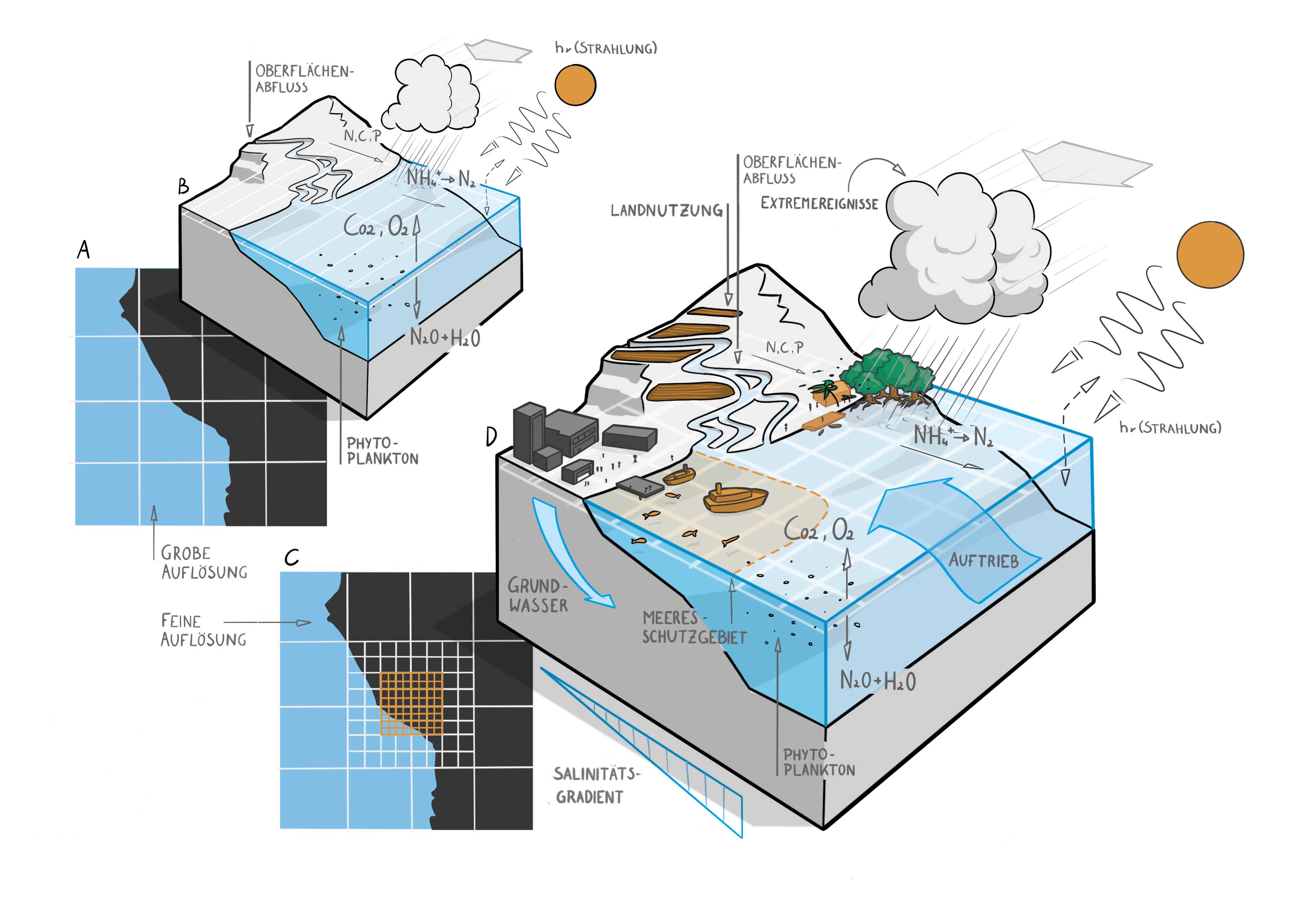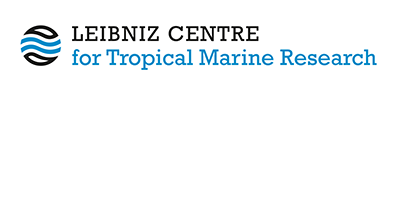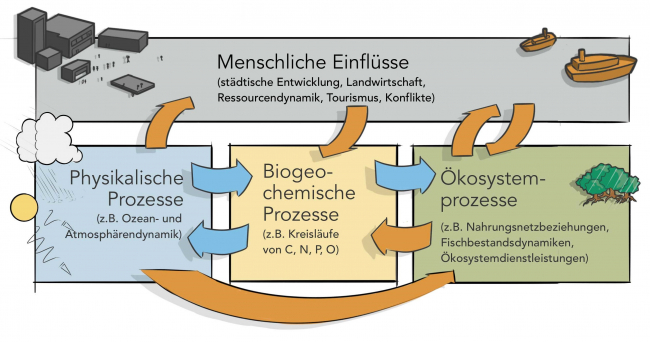ZMT strengthens research capacity with new institute extension ‘TropEcS’
Modelling is a central part of the scientific process in many disciplines in both social and natural sciences. Scientific models are the cornerstone of predictions in climate science, earth systems, and other global environmental changes.
At ZMT, researchers in all of the institute’s Programme Areas utilise various modelling techniques and different models to predict outcomes or to represent, understand, and make sense of the complex world in a systematic way.
A recently granted strategic institute extension called 'Modelling socio-economic dimensions across Tropical Coastal Ecosystems and the Earth System - TropEcS' now ensures that regional earth system modelling is further strengthened at ZMT. It will advance capacity and allow collaboration at unprecedented scale.
The strategic institute extension – called “Sondertatbestand (STB)” in the Leibniz Association’s German budget regulation – positions ZMT more directly as a key player in the modelling of the tropical coastal climate, the impact of climate change on human populations at these coasts, and the development of response strategies.
“TropEcS represents a major breakthrough in the institute’s ability to numerically and conceptually model the interaction between physical, biogeochemical and social science research questions”, says ZMT scientific director Professor Raimund Bleischwitz.
“Its aim is – by means of system understanding – to instigate new field study campaigns which are at the heart of ZMT’s existing competencies, and link them with emerging models,” adds Professor Jan Härter, Head of the working group Complexity and Climate at ZMT who helmed of the application process.
TropEcs also provides ZMT with financial means to create new positions on different career levels in the area of modelling, including a new professorial position in collaboration with the University of Bremen. These vacancies will be announced on the website in due course. “The new institute extension will enable us to get the best minds for positioning ZMT at this fascinating research frontier in the years to come”, says Raimund Bleischwitz.
The application for TropEcS was supervised and developed by Professor Jan Härter (Head of the working group Complexity and Climate at ZMT in close collaboration with Dr Christiane Schmidt (Science Management) as well as ZMT Scientific Director Professor Raimund Bleischwitz, and an entire in-house team.
The Bremen Senate strongly supported the STB throughout the whole application process which ZMT very much appreciates.

Figure 2: Conceptual diagram of modern Earth system models vs. "TropEcS" A: Coastal cross-section in a typical ESM with coarse horizontal resolution (white grid). B: Bird's eye view of a coastal area for a typical ESM. C: TropEcS dynamic grid refinement, here exemplified by two grid refinements. D: TropEcS ecosystem model representation of the coastal zone through higher resolution numerical grid with ecosystems, tides, upwelling processes, human activities and extreme weather impacts.
Deeper understanding of complex change processes affecting tropical coasts needed
Tropical coasts and their ecosystems are the most diverse and productive habitats on Earth. At the interface between ocean, land and atmosphere, they provide important ecosystem services for 40 % of the world's population.
A deeper understanding of their complex change processes is essential for climate strategies, robust preparedness against extreme weather events, and predictions of possible tipping points or ecosystem collapse. Socio-economic changes must also be considered. The aim of TropEcS is to develop the dynamics of socio-economic systems consistently with marine, environmental and climate research for tropical coasts.
In the framework of TropEcS, a new innovative modelling approach enables improved predictions that can be used to expand international partnerships.
“Being based in Bremen, the top location in marine research in Germany, ZMT is predestined for this task also as result of the already implemented STB "Digital ZMT" (DigiZ) which strengthened data science and analysis,” says Bleischwitz.
He is convinced that the new institute extension can fulfil a pioneering role in the interdisciplinary ambitions of the Leibniz Association and meet the call for a worldwide forecasting system as part of the ”Future Strategy of the German Federal Government”. “For implementing TropEcS we are looking for a modelling approach that connects boots-on-the-ground data, downscaling of Earth Systems modelling, strategic enabling of coastal communities and a possible combination of a core model with complementary approaches," Bleischwitz adds.
The new strategic institute extension TropEcS in detail - Conceptual and scientific advances
The unified coastal modelling will allow ZMT scientists to tackle problems of conceptually new characteristics. Here, three of these central advances along with scientific examples are highlighted:
(I) Coupling scales. The proposed approach will overcome frontiers and facilitate consistent coupling of scales, e.g., between local estuarine processes and global changes by local grid refinement and the explicit modelling of local interactions. Relevant processes include: short and long-distance dispersal of plankton, e.g. between marine reserves, aiding the planning of MPAs; local sources and aggregation points of plastic pollution, its spread across the world’s oceans and means to reduce its accumulation; disease spreading and potential compound effects associated with coastal flooding. Methodologically, this will be done in a combination of field measurement data combined with ocean and remote sensing data. ‘Digital twins’ and modern high-resolution spatiotemporal observations e.g. from passive and active satellite data or radar observations on hyperspectral imaging for coastal reef systems can provide large-scale context and thereby enable coupling scales. Efforts can feed into measurement methods on ocean accounting and ocean progress metrics.
(II) Exploring tipping effects. Tipping effects can arise when nonlinear feedbacks between different sub-components are present and lead to irreversible transitions. Coral reefs, the El Niño Southern Oscillation (ENSO) or African and Indian monsoon shifts have been suggested as potential tipping elements. Other environmental tipping points could be related to anthropogenic nutrient and material inputs into coastal waters leading to oxygen minimum zone formation. Our approach will allow addressing social tipping points too – referring to social disruptions either towards violence or upscaling solutions - and give evidence to research on human well-being and social justice. Tourism encounters social tipping points (at regional levels) for instance. Yet, tipping points could also be the result of specific model assumptions and subject to spatial assumptions. TropECS would provide finer-scaled and spatially explicit models to specify dynamics of tipping points and help formulating responses.
(III) Compound events. These are hazards that take place due to the co-occurrence of multiple individual events that are assumed to be independent. If the origins of the contributing events are related the likelihood of co-occurrence increases. Indeed, marine compound events such as extreme storms with precipitation and coastal flooding were recently reported to increase.Highly relevant for human well-being and social justice dynamics is, for instance, the need for fishers in Peru to embark on fishing cruises, even during risky conditions during El Niño years. TropECS will be employed to improve understanding of such complex mechanisms and describe emergent phenomena, resulting from the non-linear cross-talk between components and their traceability. Thus, devastating effects and nexus repercussions that exceed typical adaptation measures could be modelled more realistically.
(IV) Ecosystem services and biodiversity policy: The future role of ecosystem services includes coastal protection and blue carbon storage as well as the corresponding potential for climate change-mitigation and -adaptation, i.e. the ‘blue carbon wealth of nations’. The emerging controversy about the size of blue carbon stocks and their value for climate change-mitigation requires a better understanding via modelling of complex processes, interactions and interdependencies. ZMT working groups on mangrove ecology and coral reef carbonate sedimentology can generate datasets on gaps in blue carbon assessments in order to model the carbonate fluxes in these ecosystems. Those can feed directly into the finer scaled TropECS models. Simultaneous policy analysis will be required to assess offsetting efforts from industry and international accounting efforts.





